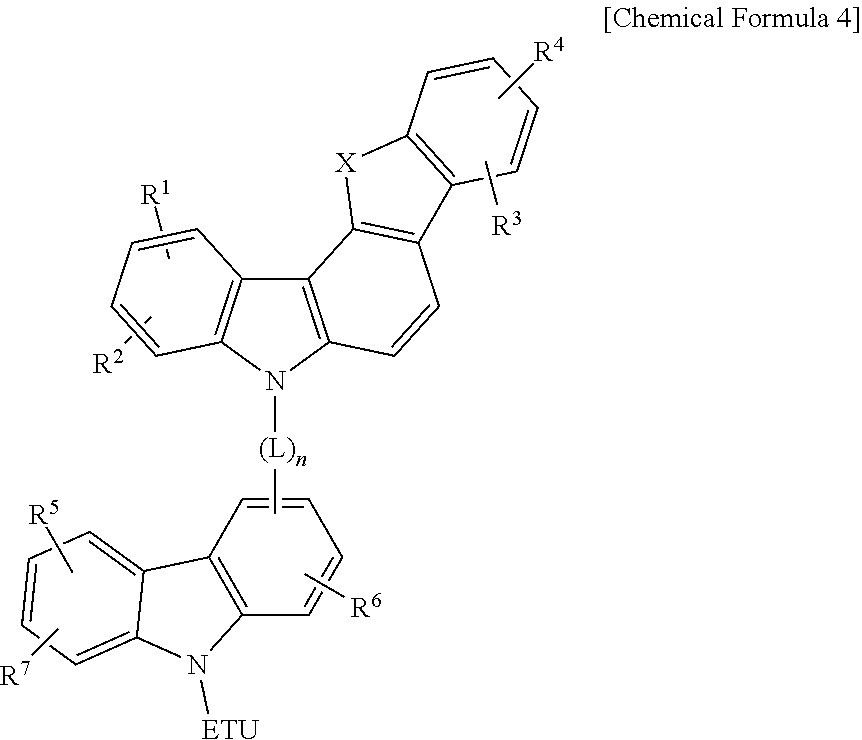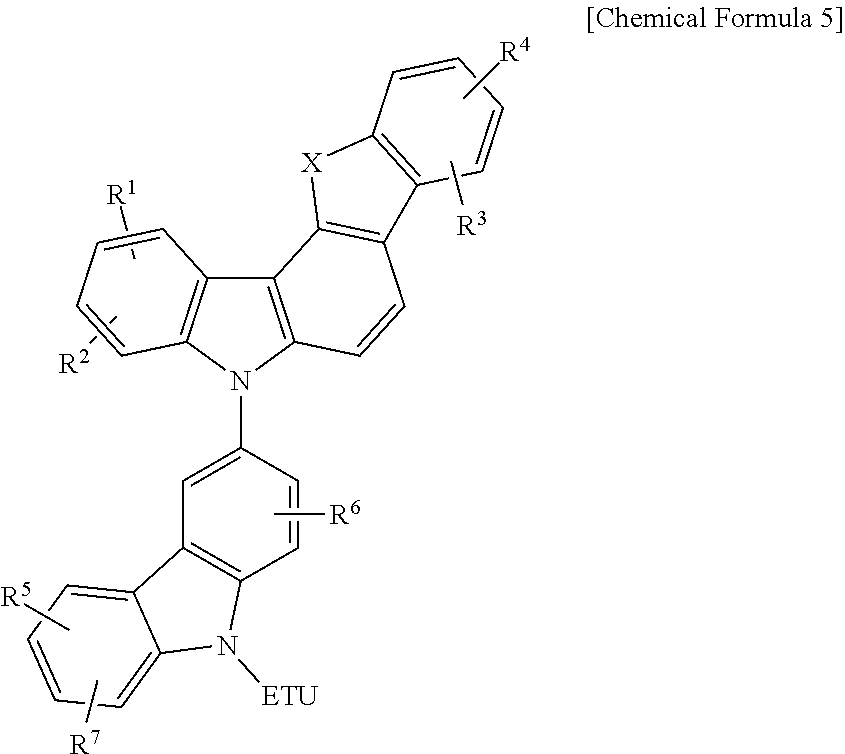Compound for an organic optoelectronic element, organic light-emitting element comprising same, and display device comprising the organic light-emitting element
a technology of organic light-emitting diodes and organic optoelectronic elements, which is applied in the direction of thermoelectric devices, sustainable manufacturing/processing, final product manufacturing, etc., can solve the problems of inefficient combination of holes and electrons, and the development of organic material layer forming materials for organic light-emitting diodes has so far not been satisfactory, etc., to achieve high triplet exciton energy, high hole or electron transport properties, and improved life-span characteristics
- Summary
- Abstract
- Description
- Claims
- Application Information
AI Technical Summary
Benefits of technology
Problems solved by technology
Method used
Image
Examples
example 1
Preparation of Compound A-1
[0112]
[0113]23.0 g of a compound A and 14.5 g of a compound B were dissolved in 350 mL of toluene under a 1 L round-bottomed flask equipped with a thermometer, a reflux condenser, and an agitator under a nitrogen atmosphere, 13.3 g of sodium tert-butoxide (NaOtBu), 2.8 g of palladium dibenzylideneamine (Pd(0)dba2), and 2.0 g of tertiarybutyl phosphorus (a 50% solution in toluene) were added thereto, and the mixture was refluxed for 12 hours in a reactor. The resultant was naturally cooling down to room temperature and precipitated in 1.2 L of methanol and then, agitated for 1 hour. A solid produced therein was filtered and added to 1.2 L of water to prepare slurry, and the slurry was agitated for one hour and then, filtered again. The filtered solid was dried and then, dissolved in 1 L of monochlorobenzene by heating, and the solution was passed through a celite / silica pad. The passed solution was heated and concentrated down to 500 mL and then, naturally ...
example 2
Preparation of Compound B-1
[0114]
[0115]23.0 g of a compound A and 13.6 g of a compound C was dissolved in 350 mL of toluene in a 1 L round-bottomed flask equipped with a thermometer, a reflux condenser, and an agitator under a nitrogen atmosphere, 13.3 g of sodium tert-butoxide (NaOtBu), 2.8 g of palladium dibenzylideneamine (Pd(0)dba2), and 2.0 g of tertiarybutyl phosphorus (a 50% solution in toluene), and the mixture was refluxed for 12 hours in a reactor. The resultant was naturally cooled down to room temperature and precipitated in 1.2 L of methanol and then, agitated for one hour. A solid produced therein was filtered and added to 1.2 L of water to prepare slurry, and the slurry was agitated for one hour and refiltered. The filtered solid was dried and dissolved in 1 L of monochlorobenzene by heating, and then, the solution was passed through a celite / silica pad. The passed solution was heated and concentrated down to 500 mL and then, naturally cooled down to room temperature....
example 3
Preparation of Compound B-4
[0116]
[0117]22.9 g of a compound D and 13.6 g of a compound C were dissolved in 0.350 mL of toluene in a 1 L round-bottomed flask equipped with a thermometer, a reflux condenser, and an agitator under a nitrogen atmosphere, 13.3 g of sodium tert-butoxide (NaOtBu), 2.8 g of palladium dibenzylideneamine (Pd(0)dba2), and 2.0 g of tertiarybutyl phosphorus (a 50% solution in toluene) were added thereto, and the mixture was refluxed in a reactor for 12 hours. The resultant was naturally cooled down to room temperature and precipitated in 1.2 L of methanol and then, agitated for one hour. A solid produced therein was filtered and added to 1.2 L of water to prepare slurry, and the slurry was agitated for 1 hour and filtered again. The filtered solid was dried and heated and dissolved in 1 L of monochlorobenzene, and the solution was passed through a celite / silica pad. The passed solution was heated and concentrated down to 500 mL and then, naturally cooled down to...
PUM
 Login to View More
Login to View More Abstract
Description
Claims
Application Information
 Login to View More
Login to View More - R&D
- Intellectual Property
- Life Sciences
- Materials
- Tech Scout
- Unparalleled Data Quality
- Higher Quality Content
- 60% Fewer Hallucinations
Browse by: Latest US Patents, China's latest patents, Technical Efficacy Thesaurus, Application Domain, Technology Topic, Popular Technical Reports.
© 2025 PatSnap. All rights reserved.Legal|Privacy policy|Modern Slavery Act Transparency Statement|Sitemap|About US| Contact US: help@patsnap.com



